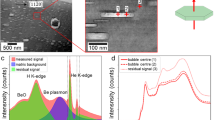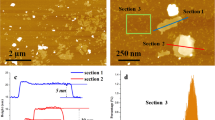Abstract
BERYLLIUM is of interest in the atomic energy field because of its low absorption and high scattering cross-section for thermal neutrons. The metallurgical properties and nuclear applications of the metal have been reviewed recently1. The electrolytic deposition of beryllium from solutions of beryllium compounds in organic solvents2 and in liquid ammonia3 has been studied. In the most recent work4, published immediately before completion of the present investigation, coherent deposits of beryllium of up to 95 per cent purity were obtained during the electrolysis of a solution containing dimethyl beryllium and beryllium chloride etherate in ethyl ether. Deposits obtained from this bath were superior to the powdery deposits obtained by electrolysis of a 2.8 M solution of BeCl2.2(C2H5)2O in ethyl ether. Although one of the commercial methods of manufacturing beryllium involves the high-temperature electrolysis of beryllium chloride5, in alkali halide melts the possibility of recovery and electro-refining of scrap metal by anodic dissolution and cathodic deposition has received little attention.
This is a preview of subscription content, access via your institution
Access options
Subscribe to this journal
Receive 51 print issues and online access
$199.00 per year
only $3.90 per issue
Buy this article
- Purchase on Springer Link
- Instant access to full article PDF
Prices may be subject to local taxes which are calculated during checkout
Similar content being viewed by others
References
Williams, L. R., and Eyre, P. B., Nuclear Eng., 3, 9 (1958). Newnham, I. E., Research, 11, 185 (1958).
Booth, H. S., and Torrey, G. G., J. Phys. Chem., 35, 2464 (1931). Booth, H. S., and Merlub-Sobel, M., ibid., 35, 2492 (1931). Dirkes, T. P., and Briscoe, H. T., Metal Indust. (New York), 36, 284 (1938). Tien, J. M., Trans. Electrochem. Soc., 89, 237 (1946).
Booth, H. S., and Torrey, G. G., J. Phys. Chem., 35, 3111 (1931). Booth, H. S., and Merlub-Sobel, M., ibid., 35, 3303 (1931). Booth, H. S., Torrey, G. G., and Merlub-Sobel, M., U.S. Pat. 1,893,221 (1933).
Wood, G. B., and Brenner, A., J. Electrochem. Soc., 104, 29 (1957).
Borchers, W., Z. Electrochem., 2, 39 (1895). Kemet Laboratories Co. French Patent 633,491 (1927). Beryllium Devel. Corp. B.P., 377,858. Kjellgren, B. R., and Sawyer, C. B., U.S. Pat. 2,188,904. Can. Pat. 429,726. U.S. Pat. 2,311,257. Can. Pat. 371,194. Jaeger, G., U.S. Pat. 1,041,131. Tien, J. M., Trans. Electrochem. Soc., 89, 237 (1946). Mantell, C. L., “Industrial Electrochemistry”, third edit., 540 (McGraw-Hill, 1950). White, D. W., and Burke, J. E., “The Metal Beryllium”, 114 (American Society for Metals, 1955). Meyerson, G. A., International Conference on Peaceful Uses of Atomic Energy, 8, 588 (Geneva, 1955). Bryant, P. S., Inst. Min. Metall. Symp., Paper No. 17 (London, 1956).
Menzies, I. A., Hill, D. L., and Owen, L. W., Pat. Applic. No. 34712/58.
Menzies, I. A., thesis, London (1957).
Author information
Authors and Affiliations
Rights and permissions
About this article
Cite this article
MENZIES, I., HILL, D. & OWEN, L. Electrolytic Deposition of Beryllium. Nature 183, 816–817 (1959). https://doi.org/10.1038/183816a0
Issue Date:
DOI: https://doi.org/10.1038/183816a0
Comments
By submitting a comment you agree to abide by our Terms and Community Guidelines. If you find something abusive or that does not comply with our terms or guidelines please flag it as inappropriate.



